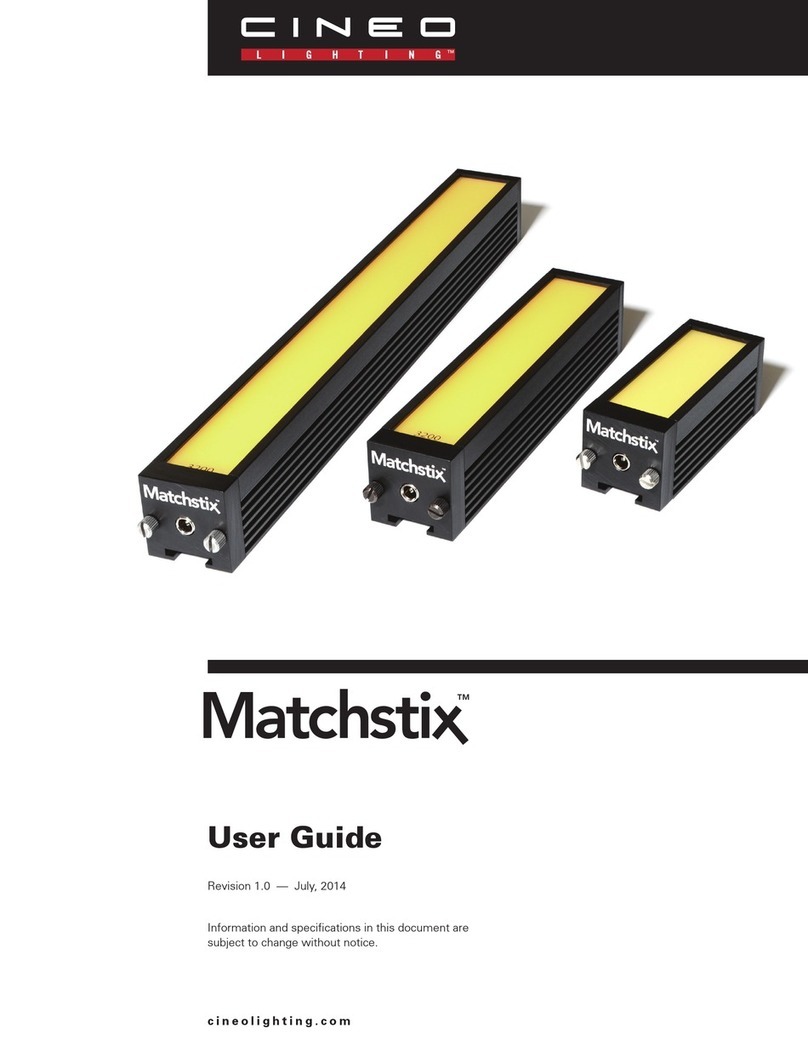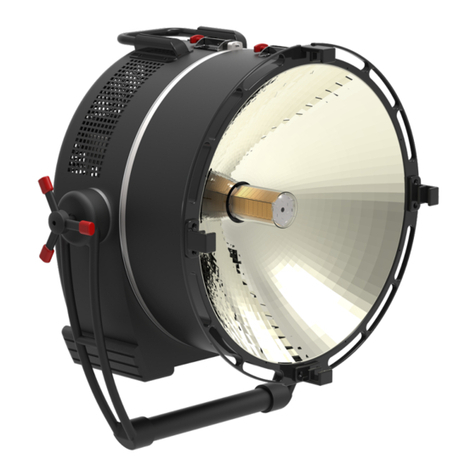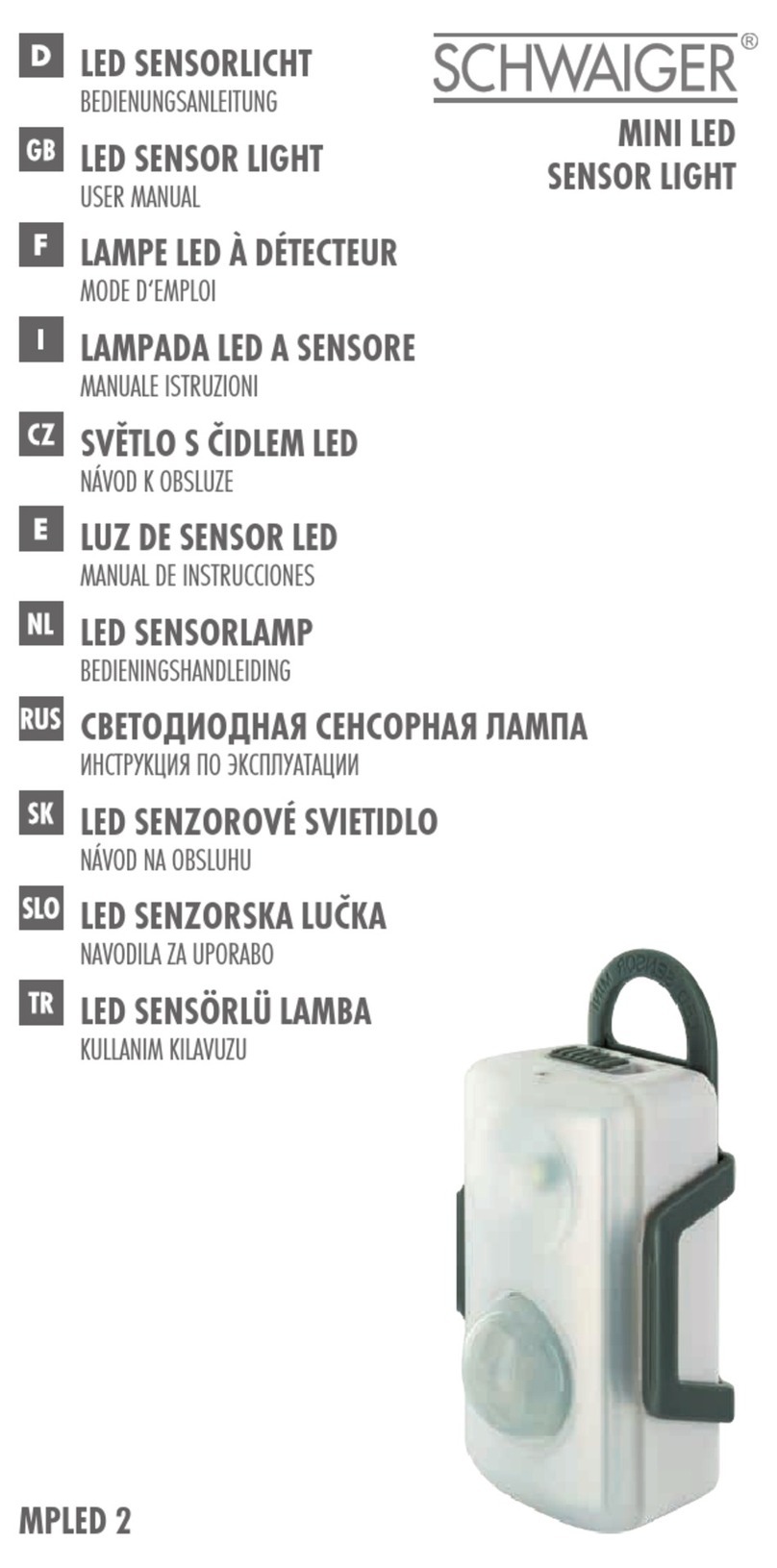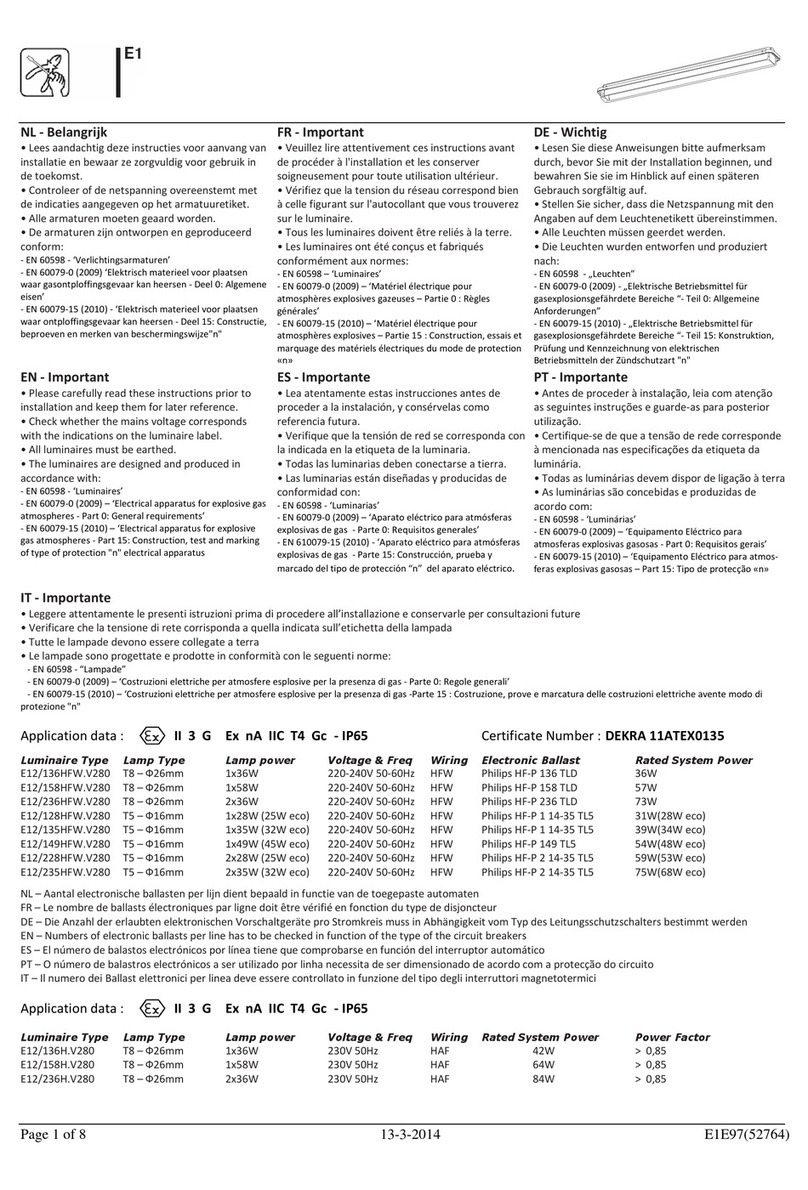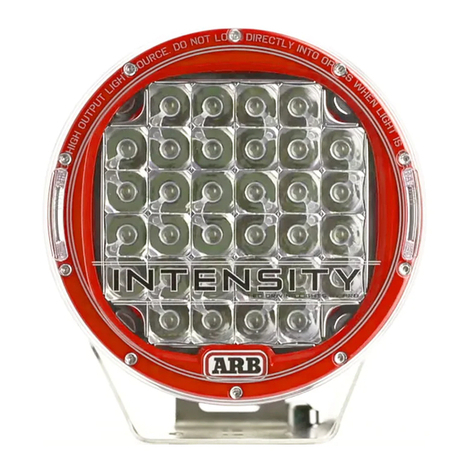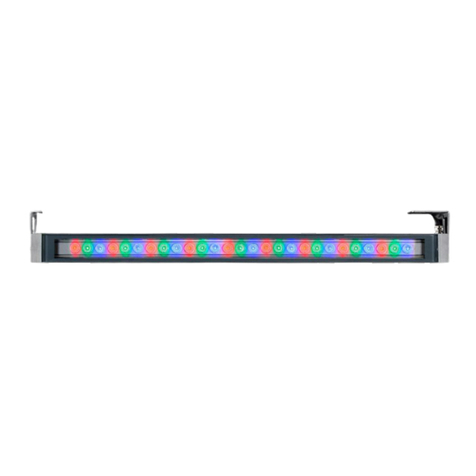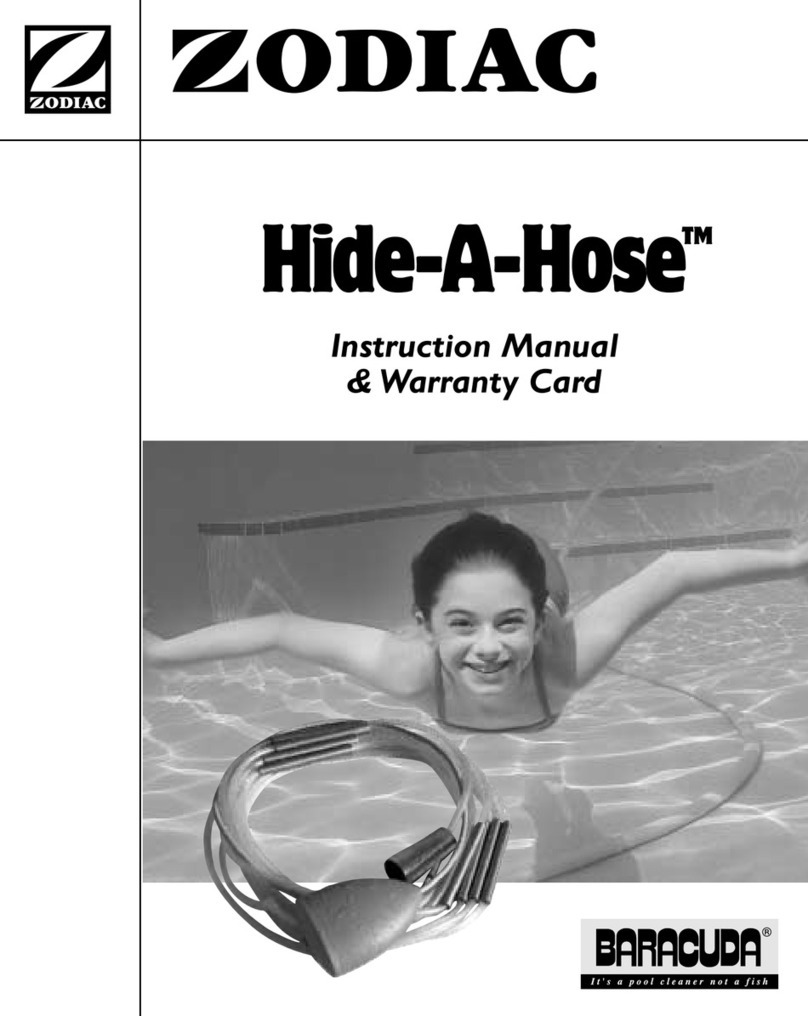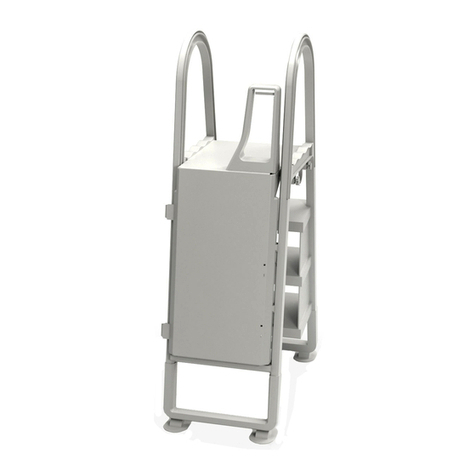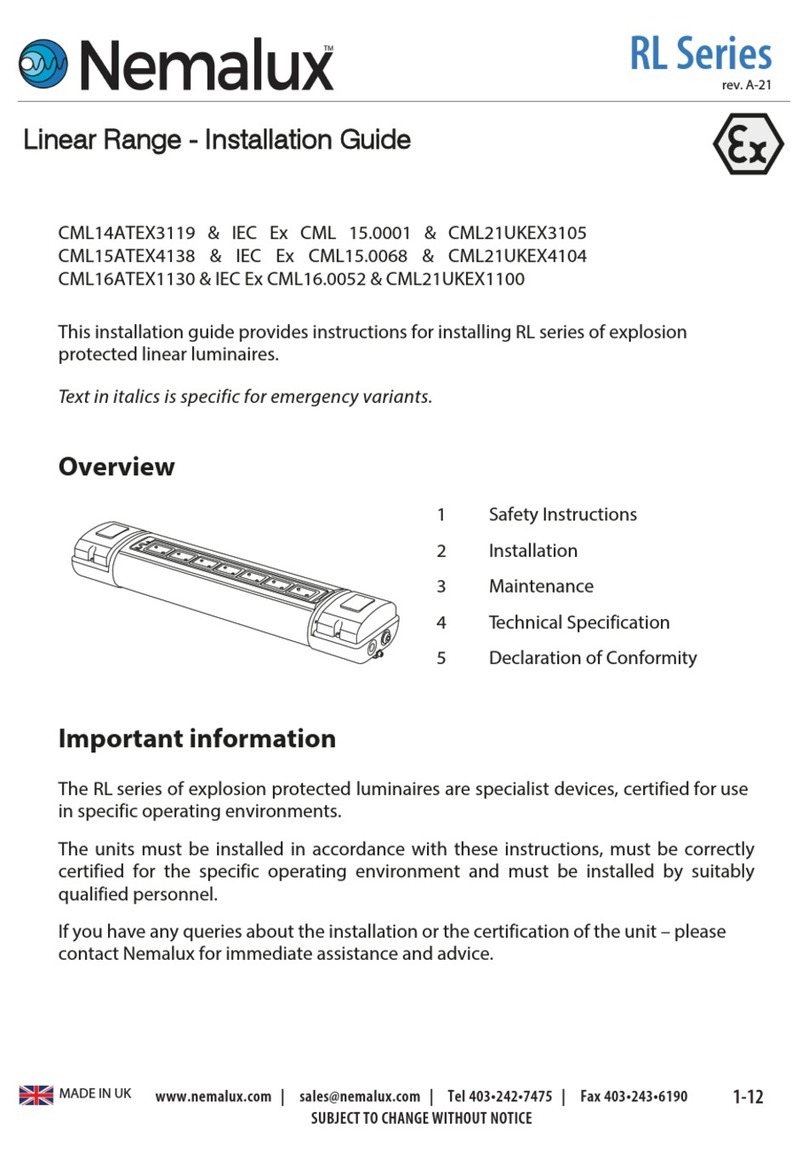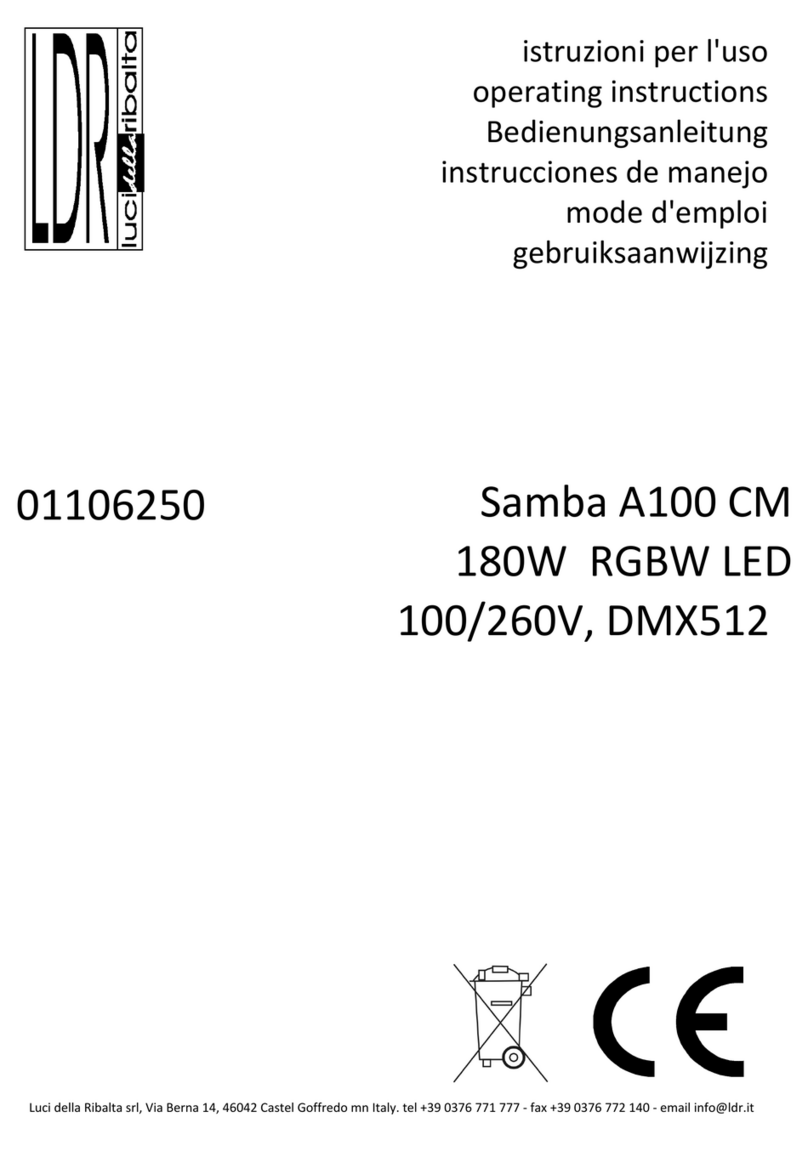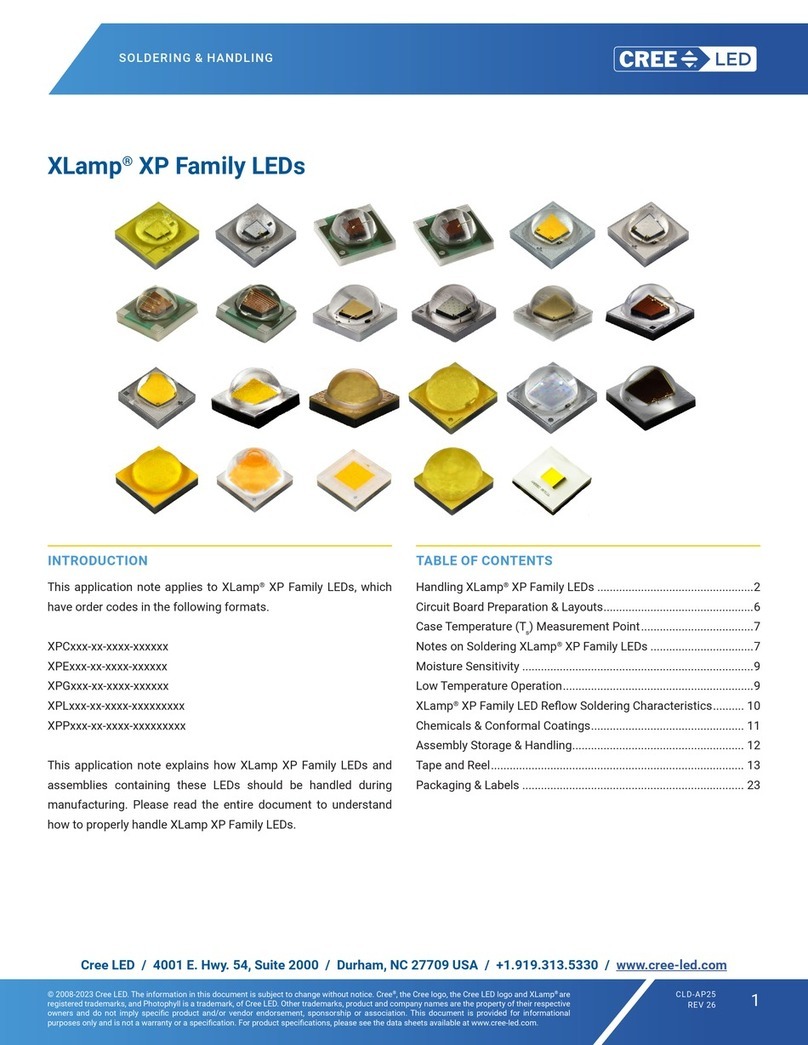Cineo LB800 User manual

LB800 User Guide
C2OS Operating System
Revision 1.1 March 2021
Information and specifications in this document are subject to change without notice.
!

Welcome to the new LB800 from Cineo Lighting
Cineo has further developed the LB800 to now include all of the features of the C2OS control environment. The LB800 delivers up to
50,000 lumens of beautiful, easily controllable, full-gamut light across a diffused 2’ x 4’ aperture. With built in power supply and
silent operation, the LB800 delivers 800 watts of power in a package that weighs 55 lbs and is less than 5.5 inches deep.
In addition to Cineo’s proprietary phosphor-converted white light LEDs, the LB800 uses phosphor-converted saturated color LEDs.
The phosphor-converted LEDs use the exact same dyes as the white LEDs, so all light emitting elements of the LB800 carry identical
thermal stability, and perform over time with identical differential aging. So after years of service, color stability remains consistent.
The LB800 now operates on the Cineo C2OS platform, a Linux-based operating system that provides a wealth of new features and
connectivity, and platform to support future StageLynx®smartstage innovations. The LB800 incorporates an intuitive control
strategy that allows predictable, repeatable results, either using the on-board touchscreen control panel or remotely with wired
DMX/RDM, built-in wireless CRMX, Ethernet/WiFi or ARTNet/sACN. Legacy LB800 units can be upgraded to support all the features
of the new C2OS version.
The Lightblade LB800 is built on a multi-zone architecture, i.e. the fixture can be operated as a single, 2’ x 4’ soft source, or it can be
operated as 10 individual fixtures in a single chassis, capable of generating dynamic lighting effects.
Local and remote operations include a variety of personalities, including:
• 1, 2 or 10 zones
• 8-bit or 16-bit DMX resolution
• HSIK, RGBK full-gamut color spaces
• Dim-only and Dim+CCT modes
The LB800 is passively cooled for completely silent operation, ruggedly built, water resistant and offers multiple mounting options
for easy setup.
Features
• Cineo C2OS Control Platform – This new platform utilizes a quad-core processor, 4GB memory, 32GB storage and operates
on industry-standard Linux OS.
• Touchscreen Control – Our new user interface means no moving parts, greater reliability and a simpler method to control
the fixture.
• Adaptive Color Space – In addition to supporting Cineo’s legacy color space (410, Blade, LB1K), we now support UCS color
space, which closely correlates to REC.2020. The color space can be selected, similar to a preset, for matching other
lighting sources and/or camera LUTs. More LUTs will be available in future releases.
• +/- Green Control – The ability to tune the fixture away from the black body curve to match other lighting sources.
• Local Zone Control – In multi-zone mode, all aspects of all 10 zones can be tailored from the touchscreen, in both HSIK and
RGBK modes. Local control operates in 16-bit resolution.
• Presets and Effects - The Cineo Preset Library will include standard gels; the Cineo Effects Library includes popular motion-
based dynamic lighting elements. Users can add their own, save them on the fixture and transport their effects and
presets via USB.
• Expanded Control Protocols – In addition to DMX/RDM and CRMX, the unit will support sACN/ARTNet, as well as being
ethernet and wifi ready for future applications.

General Notes
1. Please read through this manual carefully before operating the LB800, and keep this manual for future reference.
2. There are numerous safety instructions and warnings that must be adhered to for your own safety.
3. The LB800 is not intended for residential use. It is intended for use in a professional studio.
4. The LB800 must be serviced by a qualified technician.
5. The LB800 is rated as IP22 – for damp environments.
6. Lightblade products are not certified for use in hazardous locations.
7. The LB800 has a typical operating temperature of 50°C (122°F).
Fixture Set Up
Read these safety instructions carefully to ensure fixture and accessories are used safely.
Ensure the Junior Pin adapter is correctly mounted onto the yoke before rigging.
Always use secondary safety cables of suitable length when hanging LB800 units.
The LB800 weighs 55 lbs. (25 kg) excluding accessories. The combined weight should be considered when choosing a suitable safety
cable.
Safety cables must securely be attached to the yoke on LB800 and be as short as possible to reduce travel distance if primary
hanging accessory fails.
Ensure that the yoke lock is correctly tightened when manipulating LB800 in the required orientation for safety purposes.
Ensure the LB800 is operated within an ambient temperature range of -20 to +40°C
(-4 to 104°F).
Mounting Options
The LB800 comes standard with a fully rotational landscape-oriented yoke with a Junior Pin mount. The standard yoke can be
removed, and an optional Portrait-oriented yoke can be attached. In addition, (4) 3/8 x 16 threaded mounting points allow top-
hanging via cable harness.

Component Locations
Fixture Front
(shown with Portrait Yoke)
Fixture Rear
(shown with Landscape Yoke)
Diffuser
Accessory Slot
Accessory locking latch
Locking Knobs
Junior Pin
Hinged service
doors
Connections and controls
Mounting Points
Protective corners support stacking

Power and Communications interfaces
All connectors and system controls for the LB800 are located on the back of the unit. The touchscreen control display provides
access to menu selections, local control, effects/presets and remote-control options. Power connections and switch allow for easy
set up and strike. The DMX connections, RJ45 Ethernet port, embedded wireless receivers, RDM responders and powered USB port
support many options for external control.
Power Connector/Power Switch/Circuit Breaker
The LB800 unit is powered by an internal power supply, 110 – 220VAC via a locking PowerCon connector. Power is applied with the
switch above the connector. Maximum power draw is 900 watts. A self-resetting circuit breaker is located near the power
connection, which requires no user interaction. If the breaker trips, it will reset within one minute of tripping.
NOTES:
1. Ensure the power cable is disconnected before servicing.
2. Do not connect to a variable supply, such as a dimmer rack.
3. The power cable should be plugged into the power supply before switching the power ON. The power supply should be switched
OFF before removing the power cable.
Wired DMX Connections
LB800 uses industry-standard 5-Pin XLR male and female connectors to receive and pass-thru DMX signals and RDM signals. The
DMX port is self-terminating and does not require external DMX termination when used in a chain. If the unit is the last device on a
DMX chain, make sure that there is no cable inserted into the DMX Out connector.
The DMX pin wiring is as follows:
• Pin 1: Signal Common
• Pin 2: Data –
• Pin 3: Data +
• Pin 4: Spare
• Pin 5: Spare
RDM Support
The LB800 can remotely report unit information to an RDM controller via the RDM Identify command on either wired or wireless
DMX. The RDM information provided includes the model number (LB800), manufacturer’s number (1A0D), followed by the last 8
vales from the wifi MAC address, which corresponds to the Unit ID.
Power Switch
Power Input:
110-240 VAC
Self-resetting
circuit breaker
DMX In
DMX Thru
DMX Bridge port
Ethernet jack USB Port
Touchscreen

Functions that can be programmed remotely include the following: DMX Personality and DMX Master Address.
DMX Bridge
The DMX Bridge port is a DMX output that regenerates all communication received by the fixture. When in REMOTE mode,
whatever control method used to control the fixture (DMX, wireless, network, etc.) is outputted as a full DMX512 signal. RDM is not
supported on this port.
Ethernet Port
This waterproof RJ45 jack is used for network connections, including TCP/IP, sACN or ARTnet communications. This feature is not
currently activated but will be an available upgrade shortly.
USB Port
Type-A powered USB 2.0 port, designed to update software and up/download user libraries.
Control Console
Capacitive touchscreen for managing local control and remote communications
Touchscreen Control Operation
Home Screen
The LB800 incorporates a high-
resolution touchscreen, Linux-based
64-bit processor, 32GB storage and a
precision real-time clock. This platform
provides an intuitive user interface for
local control, system setup and
diagnostics, specialized functions and
remote operation.
The Green icons represent settings,
while the teal icons contain additional
features and the blue icons are controls.
LUTs
The first step in setting up the LB800 is
defining its overall color space and
dim characteristics. The C2OS
environment supports variable Look
Up Tables, or LUTs, which operate in a
similar fashion to camera LUTs and set
the overall characteristics of the
fixture. New LUTs will be created
periodically; however, the units
initially ship with three basic LUTs:
UCS 27-65, eUCS 20-100 and Cineo
2017.
!
!

More explanation of these are available in the appendices. The Universal Color Space LUTs (UCS) are designed
to closely match REC.2020 with linear dimming and is available in two CCT ranges: 2700-6500K (UCS 27-65) and
an extended 2000-10,000K range (eUCS 20-100). The system default is UCS 27-65.
When operating the LB800 with other legacy Cineo fixtures, the Cineo 2017 LUT matches the color space
of the Standard 410, Lightblades, C80, LB1K and older (non-C2OS) LB800 units. This LUT also selects
legacy Cineo PAD dimming curve. Choose this for compatibility with all legacy Cineo fixtures.
Personalities
This parameter defines what method of control is desired, both locally and remotely. Both HSIK and
RGBK modes are supported, each with the ability to optionally control +/- Green. In addition, two basic
personalities are included to match single CCT or BiColor fixtures, such as Cineo HS or Maverick.
Selecting these disables saturated color and creates a smaller DMX footprint for remote operation.
Zones
!
!
!
Selecting the Zone icon presents zone options for the fixture: 1, 2 or 10 zones. Note that in 1 or 2-zone
modes, the Wheel control is active. When 10-Zone is selected, the Faders control is active.
Controls
The control section is located at the bottom of the screen, identified by dark blue icons.
!
!
!
!

HSIK Controls
Wheel Control
The Wheel Cursor and Slider controls are
the simplest methods for controlling the
fixture and are available when the
fixture is in 1 or 2-Zone modes. Select
the Wheel icon, and a color wheel and
four sliders appear: DIM, CCT and HUE
and SAT. If the +/- Green Personality is
selected, this slider also appears. The
Wheel Cursor can be moved within the
color wheel to select desired saturated
color, along with the amount of
saturation added to the CCT value, set
on the slider. Using the Sliders, values
can more accurately be set. For further accuracy, press and hold the value displayed below the Slider. A keypad
is displayed so precision values can be entered.
Shortcuts are provided by tapping on either side of the slider to jump to the next or previous logical value for
the control. These are:
DIM: Increase or decrease the output in increments of 20% by tapping on either side of the slider.
CCT: Tap the slider bar to jump between 2700, 3200, 4300, 5600, and 6500.
HUE: Tapping this slider bar jumps between the six primary and secondary saturated colors.
SAT: Increases or decreases the percentage of shift from the selected CCT to the selected saturated color.
+/- G: Presets are available at .25, .5 and Full, emulating standard gels.
All control screens include the ability to
save current settings as either a Preset
or Effect, with buttons present at the
bottom of all control screens. This will
be explained in a following section.
The Home icon in the upper left corner
always returns you to the Home screen,
while the arrow icon in the upper right
corner returns you to the previous
screen. The network icon shows the
status of network connections, as well
as displaying the network menu.
2-Zone Control
!

Faders Control
When the 10-Zone mode is selected, the Faders icon is activated. Selecting this icon displays (10) Zone Sliders,
each representing either DIM, CCT, HUE or SAT for each of the 10 zones. By toggling the button in the lower left
corner, each of the four attributes for each zone is toggled. The color of the slider approximates the setting on
each zone.
Additionally, there is a Master Dim control and +/-G, if selected in the Personality. Shortcuts for both presets
and the keypad are available on all sliders. Settings for each zone can be “drawn” on the touchscreen by
dragging your finger over the slider bars. Note that if a custom 10-Zone setting is designed and unsaved, it will
be cleared when reverting back to the Wheel control.
DIM Faders
HUE Faders
SAT Faders
CCT Faders

RGBK Controls
If RGBK or RGBK+G Personalities are
selected, both Local and Remote controls
change to support control of the fixture
using primary color mixing, similar to
theatrical fixtures. When values of R, G
and B are equal, the resulting white is
adjustable via the CCT slider.!
Control screens are similar to operation in
HSIK mode, with the exception that only
the R, G, B and K values are adjustable in
1-Zone, 2-Zone and 10-Zone modes.
Tools
By touching the Tools icon, several fixture settings
are available, as well as temperature and
component monitoring status.
Time Set
The LB800 contains a crystal-accurate
clock that is the time reference for the
fixture. This includes the date and time
displays throughout the user interface, the
timestamps used for event logging and
creation/modification date stamps for all
stored LUTs, Presets and Effects. Touch
the Date, Time or 12/24-hour time format
to change any of these criteria.
Thermal
The thermal management of LB800 includes sophisticated software designed to prevent thermal stress.
CRMX Wireless
In this section, the CRMX radio linking and status are managed. The LB800 includes support for CRMX / Lumen
Radio protocol which can receive signals from CRMX and some WDMX transmitters. CRMX receivers always
automatically “Link” to the available transmitter in the vicinity. Please note that each fixture can only be linked
to a single network at a time and maintains the network ID of its previous linking. Therefore, the fixture’s
linking data must be cleared prior to linking to a new network. Touch the red button to “Unlink” the unit to a
connected wireless DMX transmitter. This line also displays the current fixture status in relationship to being
linked to a transmitter or not. It also shows the status of valid DMX data on the connection.
Refer to your wireless DMX transmitter instructions for linking fixtures to a wireless network.
Service Logs
Pressing the “Errors” button show a list of errors reported for diagnostic purposes. The “About” button displays
system information, including the software version.

Presets/Effects/Logs – Copy and Storage
By pressing the arrow button, the system
memory can be managed, as well as
providing tools to move user Presets,
Effects and Logs to/from a USB storage
device.
Presets and Effects
The LB800 is capable of recording and playing back static or dynamic settings. In all Control screens, current static
output settings for the fixture can be recorded as Presets and recalled for future use. The same is true for saving
dynamic lighting changes, created locally or played from a console via supported remote protocols and recorded as
Effects. These are organized in the Presets and Effects icons on the Home screen, with static settings stored in Presets,
and dynamic settings stored in Effects. In either area, the user can create collections of both Presets and Effects, stored
in folders called Libraries.
The LB800 is shipped with pre-built “Cineo Presets” and “Cineo Effects”, with the ability to create your own. Any Cineo
Preset or Effect can be recalled by simply selecting the stored item; it can then be modified and stored as a new item in
the “User Presets” area of Libraries.
Creating Presets
As previously mentioned, all applicable screens, including
the remote operation screen offer the ability to record a
Preset event.
Since a Preset is a snapshot of the current
settings, once the Preset button is pushed,
the user is prompted to select an existing
Library for storage, or the choice to create a
new Library.

If creating a new Library, the keypad is
displayed for naming the Library,
followed by the “New Preset” button.
Naming of the Preset follows similar
conventions.
If storing in an existing Library, “New
Preset” button is shown, along with the
existing Presets stored in the Library. The
user can choose to overwrite an existing
Preset or choose the “New Preset”
button. When the latter is chosen, an
alphanumeric keypad is then displayed
for naming the Preset.
Recalling Presets
To recall an existing preset, simply go to the Presets icon on the Home screen, choose the Library and Preset
and the fixture will recall and display the chosen Preset.
Recording Effects
Effects creation is very similar to Preset creation, except the Effects are time-based. When pressing the Effect
button from any control screen, the button changes to “Record”. It will now record all changes made to the
settings, either locally or remotely, until the Record button is pushed again. A list of Effects Libraries is then
displayed, and the ability to select a Library create a new Library, save the Effect or overwrite an existing Effect
are identical to the operation of saving Presets.
Effect Playback
Select an Effect to playback in a similar
manner to choosing a Preset; however,
when the Effect is chosen an Effect Player
is displayed. This is a very powerful tool,
allowing you to control the playback speed
and DIM level, along with the option of
looping the Effect. A start frame can be
selected by
tapping on the Time Slider, and entering a
start time.

Logs (Currently disabled)
Log files are a time-stamped history of all
settings for the fixture. Every time the fixture is
powered-on, a new Log file is created and
continues to record the events, both locally and
remotely that the fixture is doing. These Log files
are saved indefinitely unless storage space
requires automatic deletion of the oldest logs.
Typically, several weeks of previous activity can
be reviewed and recalled. There are several
purposes of the Log files, including:
• Review and recall any setting or series of
settings created before. When selected,
Log files are loaded into the Effects
player, and can be reviewed.
• Logs show the chronological usage of the fixture, for analytics purposes.
• Diagnostics. Cineo Customer Service can review the Log files as a troubleshooting tool.
Remote Operation
The LB800 can be remotely controlled using a wide range of protocols, the simplest of which is DMX/RDM. Current
release also supports the built-in CRMX wireless DMX protocol, and future releases will add sACN/ARTNet, Ethernet
and Wifi.
All functions in this area are also available via RDM, including the ability to place the unit in Remote or Local operation.
Remote Control method
By selecting this icon, current control methods are presented. In the current release, choices are DMX and
CRMX.
8/16 bit protocol
By choosing this icon, 8-bit or 16-bit DMX protocol is selected. Using 16 bits offers considerably more
adjustment resolution and doubles the number of DMX channels. Note that all Local controls operate at 16-bit
accuracy.

DMX Channels
By touching this area of the screen, a numeric keypad is displayed, providing a method to choose the starting
DMX address for the fixture. Based on the Operating Mode, Zone count and 8/16 bit data protocol, the DMX
address range is calculated and displayed in the DMX Address area.
Go DMX
The right side of the Home screen provides selection of all parameters of remote operation. The top “GO DMX”
button places the unit in remote mode, using all of the setting chosen below this.
DMX Operation Screen
When the LB800 is operating from a remote control, the following screen is displayed on the Control screen. This
provides substantial information about the current state of the unit, as well as information that may help troubleshoot
any communications issues.
All multi-zone data during remote control is
displayed on the DMX screen.
The current communication method
configured. If the unit is receiving
valid data, a green “checkmark”
indicates proper data, while a “red X”
indicates no valid data present.
The fixture address is
displayed in large numbers,
easy to read from a distance.
Touch ing the “H ome”
button cancels remote
operation, returning the
unit to Local mode.
Operating Mode
Choosing either of these buttons records a preset
or Effect, based on the fixture’s current static or
dynamic settings
Overall fixture settings.
These dynamically change
based on DMX settings.
Address range for the fixture

Specifications
Input Power: 110-240VAC, 800 watts max. via locking PowerCon connector
Integrated power supply
Fixture Size: 48” W, 24” H, 5.25” D (1.2m W, .6m H, 133mm D
Weight: 55 lbs. (25 kg.)
Mounting yoke includes Junior Pin
Variable saturated color with presets at Red, Yellow, Green, Cyan, Blue, Magenta
Variable white/color blending
Local and Remote dimming, 0-100%
5-pin wired DMX/RDM In and Thru
Integrated Lumen Radio™ CRMX bi-directional wireless DMX
Ethernet and WiFi /sACN and ARTNet ready
Completely flicker-free operation
Silent, passive cooling: no fans
Environmental temperature range: -20ºC - +40º C
Max. temperature rise: +45º C
ETL, cETL, CE pending
Made in USA
Warnings, Disclaimers and Warranty
Risk of Electric shock / Risk of Fire
Do not open. To reduce the risk of electric shock, do not remove cover (or back). No user-serviceable parts inside. Refer servicing to
qualified service personnel.
Burning Injuries
Be aware of high temperatures in excess of 50°C inside the fixture during and after use. Do not touch the LEDs to avoid burning
injuries.
Flammable Materials
Keep flammable materials away from the installation. Insure that the amount of air flow required for safe operation of the
equipment is not compromised. Proper ventilation must be provided.
ESD and LED’s
LED components used in Quantum120 are ESD (Electro-Static Discharge) sensitive. To prevent the possibility of destroying LED
components do not touch either while in operation or when switched off.
This Equipment MUST be Grounded
In order to protect against risk of electric shock, the installation should be properly grounded. Defeating the purpose of the
grounding type plug will expose you to the risk of electric shock.

AC Power Cords
Use only a rated IEC Connector. The user is responsible for ensuring power cables are of adequate condition for each application. If
the power cords are damaged, replace them only with new ones.
Environmental: Disposal of Old Electrical & Electronic Equipment
This product shall not be treated as household waste.
CINEO LIGHTING LIMITED WARRANTY
Products from Cineo Lighting are warranted against defects in materials and workmanship for two years from the date the Product
is shipped to Customer. Products are guaranteed to perform substantially in accordance with the accompanying written materials
within the warranty period under normal use.
If the Product fails to work as warranted, Cineo Lighting will, in its sole discretion, repair or replace the Product with a new or
remanufactured Product that is at least equivalent to the original Product. Customer must obtain a Return Material Authorization
number from Cineo Lighting before returning any Products under warranty to Cineo Lighting.
Customer shall pay expenses for shipment of repaired or replacement Products to Cineo Lighting’s repair facility. Any repaired or
replaced Products will be warranted for the remainder of the original warranty period or thirty (30) days, whichever is longer. Cineo
Lighting will pay shipping of repaired goods back to the customer. After examining and testing a returned product, if Cineo Lighting
concludes that a returned product is not defective, Customer will be notified, the product returned at Customer’s expense.
This Limited Warranty is void if failure of the Products has resulted from accident, abuse, misapplication, or use outside of normal
operating conditions. Warranty is void if serial number has been defaced or removed.
NO OTHER WARRANTIES. EXCEPT AS EXPRESSLY SET FORTH ABOVE, THE PRODUCTS ARE PROVIDED “AS IS” WITHOUT WARRANTY
OF ANY KIND, AND NO OTHER WARRANTIES, EITHER EXPRESSED OR IMPLIED ARE MADE WITH RESPECT TO THE PRODUCTS,
INCLUDING BUT NOT LIMITED TO ANY IMPLIED WARRANTIES OF MERCHANTABILITY, FITNESS FOR A PARTICULAR PURPOSE, TITLE
OR NON-INFRINGEMENT OR ANY OTHER WARRANTIES THAT MAY ARISE FROM USAGE OF TRADE OR COURSE OF DEALING.
ELEMENT DOES NOT WARRANT, GUARANTEE, OR MAKE ANY REPRESENTATIONS REGARDING THE USE OF OR THE RESULTS OF THE
USE OF THE PRODUCTS IN TERMS OF CORRECTNESS, ACCURACY, RELIABILITY, OR OTHERWISE AND DOES NOT WARRANT THAT THE
OPERATION OF THE PRODUCTS WILL BE UNINTERRUPTED OR ERROR FREE. CINEO LIGHTING EXPRESSLY DISCLAIMS ANY
WARRANTIES NOT STATED HEREIN. NO LIABILITY FOR CONSEQUENTIAL DAMAGES. TO THE MAXIMUM EXTENT PERMITTED BY
APPLICABLE LAW, IN NO EVENT SHALL ELEMENT AND ITS LICENSORS, DISTRIBUTORS, AND SUPPLIERS (INCLUDING ITS AND THEIR
DIRECTORS, OFFICERS, EMPLOYEES, AND AGENTS) BE LIABLE FOR ANY DAMAGES, INCLUDING, BUT NOT LIMITED TO, ANY SPECIAL,
DIRECT, INDIRECT, INCIDENTAL, EXEMPLARY, OR CONSEQUENTIAL DAMAGES, EXPENSES, LOST PROFITS, INSTALLATION COSTS,
LOST SAVINGS, BUSINESS INTERRUPTION, LOST BUSINESS INFORMATION, OR ANY OTHER DAMAGES ARISING OUT OF THE USE OR
INABILITY TO USE THE PRODUCTS, EVEN IF ELEMENT OR ITS LICENSORS, DISTRIBUTORS, AND SUPPLIERS HAS BEEN ADVISED OF THE
POSSIBILITY OF SUCH DAMAGES. CINEO LIGHTING’S TOTAL LIABILITY ON ALL CLAIMS, WHETHER IN CONTRACT, WARRANTY, TORT
(INCLUDING NEGLIGENCE OR BREACH OF STATUTORY DUTY), STRICT LIABILITY OR OTHERWISE, SHALL NOT EXCEED THE AMOUNTS
PAID BY CUSTOMER FOR THE PRODUCTS.
Customer acknowledges that the applicable purchase price or license fee for the Products reflects this allocation of risk. Because
some states/jurisdictions do not allow the exclusion or limitation of liability for consequential or incidental damages, the above
limitation may not apply. The above limitations shall apply notwithstanding the failure of any limited remedy to fulfill its essential
purpose.

Appendix A
LUT Characteristics
The C2OS introduces a more advanced and precise approach to Color Control that includes selectable Color LUTs (Look Up Tables).
The Universal Color Space (UCS) is introduced and is the recommended color space LUT on the new c2OS console for colorimetric
accuracy. In addition, the c2OS can use a different LUT to reproduce Cineo2017 (the original color space used on the c80,
Standard410, LightBlades and LB800 products). In the future Cineo will be introducing more LUTs that will be used to map to other
color spaces and other fixtures. This document explains how Cineo c2OS Color and LUTs work with an explanation of the color
theory behind it.
REC2020 compared to Cineo 2017 LUT and UCS 27-65 LUT
CIE 1931 – Color data shown in this report is actual test data measured using a Sekonic c7000
UCS LUTs
UCS 2.0 LUTs are the preferred color space for the latest Cineo fixtures. It offers higher color precision, correlated to REC.2020 and
provides accurate linear dimming. Saturation control and Hue controls are more precise. Two UCS LUTs are offered in the initial
release on C2OS: UCS 27-65, with a CCT range of 2700K-6500K, and eUCS 20-100, with a range of 2000K to 10,000K.
Cineo 2017 LUT
Use when operating older Cineo fixtures with C2OS fixtures. This LUT matches the colors of the older S410, LB1000 and other Cineo
legacy fixtures.

The Cineo 2017 uses a Photo-Accurate Dimming curve, which offers light output congruent with lens stops on a camera.
Here are examples of how to accurately match camera stops to dimming levels in Local Mode:
Local Dimming: The Rule of 20 (0-100 scale)
Increase output 1 Stop: Add 20 units (fc/lux is doubled)
Decrease output 1 Stop: Subtract 20 units (fc/lux is reduced 50%)
Adjust ½ Stop = 10 Units (0-100)
Adjust ¼ Stop = 5 Units (0-100)
When operating in DMX mode, each increase of 50 units (8-bit) doubles the light output, or the equivalent of opening the lens 1 f-
stop.
DMX Value % Output increase Stop Increase
(0-255)
50 100 0
100 200 1
150 400 2
200 800 3
250 1600 4
Here are examples of how to accurately match camera stops to dimming levels in DMX Mode:
DMX Dimming: The Rule of 50 (0-255 scale)
Increase output 1 Stop: Add 50 DMX values (fc/lux is doubled)
Decrease output 1 Stop: Subtract 50 DMX values (fc/lux is reduced 50%)
Adjust ½ Stop = 25 DMX Values
Adjust ¼ Stop = 12 DMX Values
The following table lists all the 8-bit DMX values for all of the fixture presets:
Dimming CCT Saturation Hue
100% 255 2700K 000 0% 000 Red 000/255
-1 Stop 200 3200K 034 10% 025 Yellow 043
-2 Stops 150 4300K 107 20% 050 Green 085
-3 Stops 100 5600K 195 50% 128 Cyan 127
-4 Stops 050 6500K 255 80% 204 Blue 170
Off 000 100% 255 Magenta 212

!
Appendix B
DMX Personalities: LB800 with C2OS
PERSONALITY
DESCRIPTION
SLOT COUNT
1
1-Zone 8-bit HSIK
4
2
1-Zone 16-bit HSIK
8
3
1-Zone 8-bit RGBK
4
4
1-Zone 16-bit RGBK
8
5
1-Zone 8-bit HSIK-G
5
6
1-Zone 16-bit HSIK-G
10
7
1-Zone 8-bit RGBK-G
5
8
1-Zone 16-bit RGBK-G
10
9
10-Zone 8-bit HSIK
41
10
10-Zone 16-bit HSIK
82
11
10-Zone 8-bit RGBK
41
12
10-Zone 16-bit RGBK
82
13
10-Zone 8-bit HSIK-G
42
14
10-Zone 16-bit HSIK-G
84
15
10-Zone 8-bit RGBK-G
42
16
10-Zone 16-bit RGBK-G
84
17
2-Zone 8-bit HSIK
8
18
2-Zone 16-bit HSIK
16
19
2-Zone 8-bit RGBK
8
20
2-Zone 16-bit RGBK
16
21
2-Zone 8-bit HSIK-G
10
22
2-Zone 16-bit HSIK-G
20
23
2-Zone 8-bit RGBK-G
10
24
2-Zone 16-bit RGBK-G
20
25
1-Zone 8-bit DIM-Only
1
26
1-Zone 16-bit DIM-Only
2
27
1-Zone 8-bit DIM + CCT
2
28
1-Zone 16-bit DIM + CCT
4
29
2-Zone 8-bit DIM-Only
2
30
2-Zone 16-bit DIM-Only
4
31
2-Zone 8-bit DIM + CCT
4
32
2-Zone 16-bit DIM + CCT
8
33
Local Control
-
Table of contents
Other Cineo Lighting Equipment manuals
